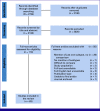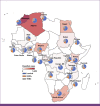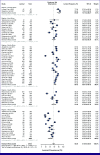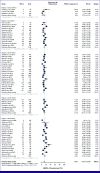Breast Cancer Phenotypes in Africa: A Scoping Review and Meta-Analysis
- PMID: 38085060
- PMCID: PMC10846770
- DOI: 10.1200/GO.23.00135
Breast Cancer Phenotypes in Africa: A Scoping Review and Meta-Analysis
Abstract
Purpose: Africans have been associated with more aggressive forms of breast cancer (BC). However, there is a lack of data regarding the incidence and distribution of different subtypes on the basis of phenotypic classification. This scoping review and meta-analysis was undertaken to determine the distribution pattern of BC phenotypes (luminal, human epidermal growth factor receptor 2 [HER2]+, and triple-negative breast cancer [TNBC]) across the African region.
Methods: Four online databases (PubMed, Scopus, ProQuest, and EBSCOhost) were accessed to identify studies published between 2000 and 2022 reporting the representation of receptor status (estrogen receptor, progesterone receptor, and HER2) in African patients with BC. Furthermore, the meta-analysis was carried out using a random-effects model and pooled using the inverse variance method and logit transformation. 95% CI and I2 statistics were calculated using the Clopper-Pearson method to estimate between-study heterogeneity.
Results: A total of 2,734 records were retrieved, of which 2,133 were retained for further screening. After the screening, 63 studies were finally selected for the scoping review and meta-analysis. The pooled frequency of luminal, HER2-positive (HER2+), and TNBC was estimated at 56.30%, 12.61%, and 28.10%, respectively. Northern Africa had the highest frequency of the luminal subtype, while West Africa showed higher frequencies of HER2+ and TNBC subtypes. The review also had a representation of only 24 countries in Africa.
Conclusion: Our results highlight the disparity in the representation of molecular subtypes among the people in different regions of Africa. There is a need to incorporate routine molecular subtyping into the management of African patients with BC.
Conflict of interest statement
The following represents disclosure information provided by authors of this manuscript. All relationships are considered compensated unless otherwise noted. Relationships are self-held unless noted. I = Immediate Family Member, Inst = My Institution. Relationships may not relate to the subject matter of this manuscript. For more information about ASCO's conflict of interest policy, please refer to
Open Payments is a public database containing information reported by companies about payments made to US-licensed physicians (
No other potential conflicts of interest were reported.
Figures





References
-
- Sung H, Ferlay J, Siegel RL, et al. : Global cancer statistics 2020: GLOBOCAN estimates of incidence and mortality worldwide for 36 cancers in 185 countries. CA Cancer J Clin 71:209-249, 2021 - PubMed
Publication types
MeSH terms
Substances
LinkOut - more resources
Full Text Sources
Research Materials
Miscellaneous

